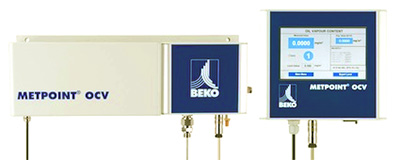Medical Compressed Air System by Beko Technologies
The uses of compressed air are pretty much universal from pumping up your car tyres to sophisticated control systems for industrial processes. In the medical sphere compressed air is used to operate simple mechanical devices such as drills and saws, ventilators and as a carrier gas in anaesthesia and inhaled medications. Compressed air at source is ambient air which has passed through a mechanical device (the compressor) which in industrial applications sometimes comes into contact with the lubricating oil. In more “quality” applications the compression chamber is usually dry of any lubricating medium.

Photo by Beko Technologies
Water is a well known contaminant of compressed air based on the fact that ambient air containing an average 60% Relative Humidity is drawn into the compressor and taken to 7 bar(G) which means an absolute compression ratio of (7+1)/1 = 8. Simple maths tell that with the water content now 8 times the original something has to happen and the physics is that the temperature rise steeply during compression and the air is 100% saturated but any reduction in this temperature will cause condensation. This condensation when oil is present is acidic and aggressive to piping and joints and obviously has to be removed before ingestion by or contact with a patient.
This is the easy part to solve. Compressors today come in a wide range of options to be oil less and with a cooler built in to condense the bulk of the moisture inside a compressor package. Then the residual water vapour can be removed by well known proprietary devices called dryers which may use refrigerant or a desiccant medium to remove water to the required level. Filters can remove oil, oil vapour and aerosol if present down to 0.006 mg/m³ when standard oil removal filters and carbon adsorbers are used. So if we have oil less compressors and a compressed air dryer with good filtration is that the end of the story? Sadly not we have to consider other risks. The measurement of the pressure and the dew point (the temperature at which water will condense out) is easy and low cost and very well known to engineers. So what else does the hospital engineer need to think about?
He might think…I am monitoring dew, point and pressure and I have alarms and shut downs…I am OK.
Wrong! Ambient air contains 150 million dirt particles approximately 70% of which are smaller than the compressor intake filter. Ambient air also contains 0.05-0.5mg/m³ of hydrocarbons. There are two problems here. If an oil less compressor is selected it may be thought that there is no need for oil removal filters…sounds logical? Secondly if a lubricated compressor is the base then often a small paper filter impregnated with carbon is offered as the final oil removal device. So the operational issues behind this are that the oil less solution working perfectly mechanically is still drawing oil vapours in, concentrating them via the compression process and then delivering them to the system. In the case of the lubricated solution the filter life is only 100’s of hours compared to 1000’s of hours for other devices.
So what needs doing to obviate the risk? There is a mantra in business “what gets measured gets done” or as BEKO TECHNOLOGIES put it “To Manage we must Measure!” The oil vapour should be measured and this is being taken up strongly by the medical sector in some European countries such as the Benelux region. BEKO TECHNOLOGIES have an instrument designated METPOINT OCV which will continuously measure the remaining oil vapour content in compressed air systems down to 0.006 mg/m³ with on board data retention and compatibility with current communication systems to enable trend management and shut down if required. In many installations where the METPOINT OCV device has been installed the user has been shocked to see readings for oil vapour where he though none could be present. Therefore the risk can be negated by measuring and if any vapours are present by the installation of a carbon tower which contains enough material to match the
system norms for maintenance interval.
For further information visit: www.beko.de
News Categories
- » NEWS HOME
- » Automation & Robotics
- » Industry 4.0
- » Material Handling
- » Sensors
- » Quality & Testing
- » Machine Vision
- » Laser & Optics
- » Metalworking
- » Motion Control & Drives
- » Hydraulics & Pneumatics
- » Process Industry
- » Renewable Energy
- » Agriculture
- » Home & Office Furniture
- » Environmental Tech


